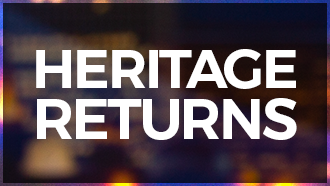Cherokee Tribe Brings American Bison Back To Oklahoma
One month ago, a herd of Bison from Badlands National Park arrived here in Oklahoma. They're now on Cherokee tribal land in Delaware County.Thursday, November 13th 2014, 11:22 pm
One month ago, a herd of Bison from Badlands National Park arrived here in Oklahoma. They're now on Cherokee tribal land in Delaware County.
We went to the Badlands in South Dakota to learn the story behind the story, the program that made the bison delivery possible.
Over time, receding water from a once-shallow sea carved the canyons, spires and buttes that make Badlands National Park so breathtaking.
Ancient animals like the saber-toothed cat roamed the area that's now home to bighorn sheep and prairie dogs that thrive in the 244,000-acre national park.
It's also home to the largest undisturbed mix of prairie grass in the U.S. which is perfect for bison.
"When I drive through here, even though I'm from here, I still think about those massive herds that roam through here and my ancestors following them and thinking about what it was like back then, and luckily we have a spot that is still preserved and it's as it was 200 years ago," said Troy Heinert with the Intertribal Buffalo Council.
Greed and the U.S. government nearly brought the American bison to extinction. Once numbering in the millions, buffalo were slaughtered and by the late 1800s only a few hundred remained.
"As Indian people, they were everything to us. They provided food, shelter, clothing, all of our tools," Heinert said.
The U.S. government waged war on a way of life to manipulate Plains Indians by eliminating their primary source of food.
Non-Indian buffalo hunters sent the hides back east or to Europe where bison tongues were considered a delicacy.
The ground up bones became fertilizer, but just about everything else was left to rot.
"We just about wiped this animal off the face of the planet and, luckily, there were some people that had some foresight and saved them and we were able to build them back up," said Heinert.
When Heinert sees old pictures of piles of buffalo skulls, it breaks his heart; but now it does his heart good to see the resurgence of the American bison.
"It's in our DNA to love buffalo, but just for everyone to look at that majestic animal, it's something special to see," he said.
Heinert works for the Intertribal Buffalo Council, a group formed to relocate the thriving buffalo herds from national parks to Native American tribes.
Recently, 40 females from the Badlands made their way to the Cherokee Nation in Oklahoma.
"I'm very excited Cherokee Nation is getting buffalo," Heinert said.
This year's bison round up is the largest ever at Badlands National Park, with 1,000 of the animals herded from the wide open range to holding pastures, then to corrals and gradually being worked through chutes by national park staff.
National Park Service Biologist, Eddie Childers said, "When you work with them here, they're a little different; they're not cattle. As you can see we have a quiet area here. As we process them through the chutes, we keep everything low key and at a minimum."
Experts take blood samples to test for Brucellosis, a bacterial infection that can spread from animals to people.
"We have the height and weight and sex of course," Childers said.
Other information, including DNA, goes into a database, and the Bison are micro-chipped.
"As soon as the animal comes through the squeeze chute, Paul will wave that flat paddled scanner across the right ear," Childers said.
Then, the screened animals are loaded onto trucks and delivered to tribes.
Wildlife experts at the Badlands National Park in South Dakota try to keep the Bison herd at one-third of what they call the ecological carrying capacity. Anything above that is considered surplus and the rest of the country benefits, including the Cherokees in Oklahoma.
"We know they'll be well taken care of," said Childers.
Heinert said, "The animals that are here at Badlands are just outstanding specimens, and I just think it's going to be a great thing for the Cherokee people."
Finally, after nearly two years of paperwork, inspections, and coordination, and a 14-hour haul, Heinert delivered the animals to the Cherokee Nation in Oklahoma.
One by one, the massive animals were coaxed off the trailer and onto tribal land.
"They're a very pure strain of buffalo, and that's what we want, and that's what our tribes want," said Heinert.
At a site in Delaware County, the magnificent Badlands bison are welcomed by tribal leaders, and a traditional Cherokee buffalo song.
10/9/2014 Related Story: Herd Of Cherokee Nation Bison Arrives In Delaware County
Natural Resource Director with the Cherokee Nation, G.V. Gulager said, "It's going to bring back heritage, it's going to bring back tourism, it's going to bring back the symbolic nature of the Native American and the buffalo and how they intertwined together."
The Cherokees have 66 acres fenced off for the buffalo herd now, but will expand it to 250 acres.
So, the animals that dotted the rugged landscape of the South Dakota Badlands, made the 800 mile relocation to now roam and feed on the native grasses of Oklahoma.
It's a delivery bringing a special part of tribal history, with cultural and spiritual significance to the Cherokee people.
"I think it will be a wonderful sight, and a thrill to come and look at the buffalo," Gulager said.
The Cherokee Nation has also added 12 bull bison from Teddy Roosevelt National Park in North Dakota.
More Like This
November 13th, 2014
February 22nd, 2022
February 22nd, 2022
February 22nd, 2022
Top Headlines
June 13th, 2025
June 13th, 2025
















